From Rail Splitter to President
Article and Photos (except as
noted) by Kathleen Walls
;
 |
Abraham Lincoln Birthplace
Memorial
(Credit NPS) |
I've
devoted a lot of space to Confederate persons and sites. I'm
a Southerner, what else can I say. Still, in all fairness,
the Federal side deserves some space. So this
Civil War Trails
will look at the Union's top man,
Abraham Lincoln. In particular one town that begun
his catapult to 1600 Pennsylvania Ave.
Illinois
gets most of the recognition for Lincoln sites you need to
visit but don't forget–shame on you if you didn't know
it–Lincoln was born in Kentucky near Hodgenville.
Ironically less than a year and about a hundred miles
separate the time and places of Lincoln and his Confederate
counterpart, Jefferson Davis' birth in Fairfax, Kentucky
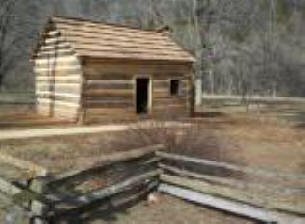 |
| Knob Creek Cabin (credit
NPS) |
The
Abraham Lincoln
Birthplace National Historic Site is your first
chronological stop on the trail of Honest Abe. In
1911, a neo-classical memorial was dedicated on the site
known as Sinking Springs where Abraham Lincoln was born.
This elaborate Memorial Building features 16 windows, 16
rosettes on the ceiling, and 16 fence poles, representing
Lincoln's being the 16th president. It has 56 steps leading
up to the entrance represent his age at his death. In spite
of the building's beauty, what people from around the world
come to see is a simple 12 by 17 foot log cabin that was
placed inside. The cabin is similar to the one in which the
16th president was born.
Lincoln
lived at Sinking Spring until he was
two years old,
then because of a title dispute his father, Thomas, moved
the family a few miles northeast to another farm on
Knob Creek, where they remained until young Abe was
seven years old.
The Knob Creek site is preserved at the Birthplace Site as
well. On this portion of the site, there is a 19th century
log cabin that may have belonged to neighbors of the
Lincolns and was moved to the spot where the original
Lincoln cabin once stood. The Lincolns lived there until Abe
was seven.
The next move brought the growing family to Indiana. Besides
Abraham, the Lincolns had a daughter, Sarah,
two years older than
Abraham. There had been another boy born while the family
was living at Knob Creek around 1811. It is believed the
child, named Thomas after his father,
died in 1815 and was
buried in the Redmon Cemetery near Knob Creek.
 |
Living history at the Lincoln Boyhood site
(credit NPS) |
The next stop on your "Discover Lincoln Trek" is the
Lincoln Boyhood National Memorial near present day
Lincoln City, Indiana. The museum here provides a film about
young Lincoln's years in Indiana. Naturally the museum is
filled with artifacts related to Lincoln and his family. The
actual footprint of the Lincoln home is still visible and
preserved here. A
short distance from the original cabin site you will find a
living history site complete with a replica farm house.
Rangers in full period clothing reenact the everyday life of
a poor farm family so you are given a glimpse of what life
was like for the Lincolns and their neighbors. The rangers
actually cultivate
crops, raise livestock, and use the traditional farm
implements of the period. If you are serious about immersing
yourself in this lifestyle,
you can take classes and learn more
about the
1820s-style farm lifestyle. The Living Historical Farm is
open seasonally, from mid-spring to early fall.
Perhaps this is where young Lincoln began to form his early
anti-slavery beliefs. His father left Kentucky, a slave
state, to move to a free state in part because he couldn't
compete with larger slave operated farms in Kentucky. Here,
too, is where the family joined the small Little Pigeon
Primitive Baptist Church. This church had split with the
main body of Baptists because they opposed slavery.
It was while they lived here that Abraham's mother, Nancy
Lincoln, died of Milk Fever, an illness caused by drinking
milk or eating meat from cows who had eaten white snakeroot
plant whick contained a deadly toxin. She is buried nearby
in the Pioneer Cemetery. Sarah Lincoln also died here and is
buried with her husband and children across the street in
the Little Pigeon Baptist Church Cemetery.
The church is located I the Lincoln State Park. The present
church is the third one built on the site all that remains
of the original is a corner stone propped against the
present church wall.
 |
Lincoln Douglas Square in Alton
Photo Credit Alton CVB |
But one place that was vitaly important as a springboard
from Young Abe Lincoln, the
lawyer, to President Lincoln, The Great
Emancipator, is a town where
Lincoln did not
actually live but
visited often and is considered where he first achieved
national prominence; Alton, Illinois. The town has a
well marked Lincoln and
Civil War Legacy Trail of 10 sites you do not want to
miss. You can pick up the brochure at the CVB office or
access it on your cell by calling (618) 767-6122 then
enter the site number (1-10) then the pound key.
When Lincoln moved from New Salem, Illinois
to Springfield, the capital,
it was probably because he planned his destiny as a
political personage. Did he aim higher than the Illinois
senate?
Perhaps.
Lincoln's name is intertwined with the Free State- Slave
State Issue. One of his first published speeches, the
Lyceum Address, was made to the Young
Men's Lyceum of Springfield
on January 27, 1838. It was
titled "The
Perpetuation of Our Political Institutions" and in it
Lincoln made reference to the murder three months earlier of
Elijah Lovejoy in
Alton, Illinois.
 |
|
Lovejoy Monument on
Alton's Lincoln Trail. |
Lovejoy, a Presbyterian minister who published an
abolitionist newspaper called
The Observer. He
originally published it in St. Louis, Missouri but when
public sentiment became too strong against him, he moved
across the river to Alton. He was not welcomed there with
open arms. His press was taken three times and thrown in the
river. The fourth time he vowed to defend it. He did and it
cost him his life. No one was ever convicted for the murder.
He is considered the first martyr for freedom of the press
and, by some, the first casualty of the Civil War. His grave
and monument is part of
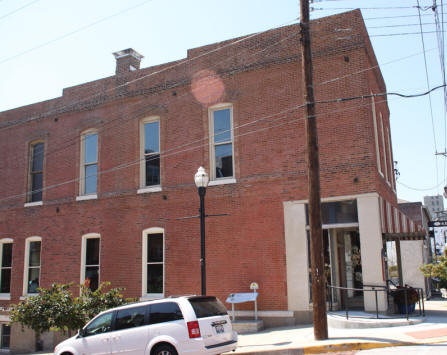 |
| The Ryder Building |
The Ryder Building is another site you want to visit. (Even
if you are not a history buff, it now houses My Just
Desserts, one of the best lunch restaurants in town. The
pies are all homemade and glorious.)
During Lincoln's early law practice days, the
building was used a s a courthouse, possibly where a jury
acquitted the man accused of murdering Rev. Lovejoy was
held.
At one time, Lincoln represented the owner of the Ryder
Building in a matter of collecting a debt. There is a copy
of a signed letter by Abraham Lincoln telling Simeon Ryder
that he had won the case. The original is in the Hayner
Public Library.
It was here, in 1840, that Lincoln made a speech supporting
William Henry Harrison, the Whig presidential candidate.
Another little known fact about Lincoln occurred in Alton.
Most people do not know he was involved in a duel. One that
never actually happened. The scene of the duel was an island
in the middle of the river that was out of Illinois
jurisdiction as duels were illegal in the state at that
time. The site is marked on the trail by a marker on the
Riverwalk across from the Amphitheater. It was a comedy of
errors from the beginning. Lincoln was a state legislator at
the time. Shields who had been his friend although members
of opposing parties, became State Auditor. Lincoln did not
agree with Shields decisions and wrote a series of letters
using a pseudonym lampooning Shields for his incompetence.
Mary Todd and her friend Julia Jayne joined into the letter
writing campaign and it became embarrassing for Mr. Shields.
On finding out Lincoln was behind it, Shields challenged him
to a duel.
Lincoln had no choice but to accept or be branded a coward
and lose important votes down the line. Naturally, Lincoln
accepted and as challenged party, had
the choice of weapons. He chose the largest
broadsword available.
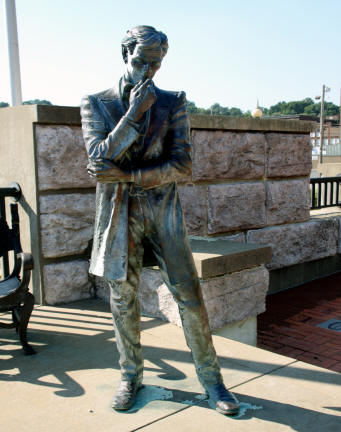 |
| Lincoln's stature in Lincoln
Douglas Square |
When they reached the island on September 22, 1842., Lincoln
made a show of chopping branches overhead with his
broadsword that the much shorter Shields could not even
reach. Shields saw the error of his ways very quickly and
agreed to settle if Lincoln would just write a letter
acknowledging the newspaper letters. The two gentlemen
returned to Alton once again friends, albeit a bit cooler
than preciously, and
more important both alive.
Ironically, during the war, Lincoln commissioned Shields as
a Brigadier General and spoke highly of his bravery under
fire.
Another friend and political rival figured in Lincoln's rise
to power. Lyman Trumbull. Trumbull and Lincoln were friends.
Their wives were best friends and Julia Jayne Trumbull and
Mary Todd Lincoln had been bridesmaids at one another 's
weddings. In the U. S. senatorial race in 1854, Trumbull was
pitted against
Lincoln, James Shields, former Illinois Governor Joel
Matteson and several other lesser candidates. At that time
the state legislature elected the U. S. senators. The big
issue of the day was the recent bill, the Kansas -Nebraska
Act, introduced by Steven Douglas and pushed through
Congress allowing any territory to vote if they wanted to be
aslave state or free state. (For more about this see
http://www.americanroads.net/heritage-trail-fall08.htm)
The Illinois legislature was split on this act. Lincoln and
Trumbull were firm anti-Nebraskans, as those who opposed the
bill were called. Shields was a strong Douglas supporter.
Matteson had taken no public stand on the issue but
Lincoln knew that he was in fact a supporter of the bill.
Lincoln had campaigned strongly and even resigned his state
legislature seat pinning his hopes on this senatorial
election but when it became clear the legislature was
deadlocked. Shields had 41 votes and the anti-Nebraskans
votes going 44 for Lincoln and five for Trumbull. Nine other
votes were split between Matteson and lesser candidates.
Then the Democrats switched their votes from Shields to
Matteson. Lincoln fearing a Douglas supporter would win
withdrew and tossed his votes to Trumbull. Trumbull remained
a firm Lincoln supporter for the remainder of his career. He
served eighteen years in the senate and as chairman of the
Senate Judiciary Committee, helped draw up the 13th
amendment abolishing slavery. However, Mary Todd Lincoln
refused to ever again speak to her former friend, Julia Jayne
Trumbull.
The Trumbull House is a private residence located at 1105
Henry Street in Alton. It is considered a National Landmark.
It became increasingly clear that Abraham Lincoln and
Stephen Douglas were inevitably pitted against t each other.
One favoring
limiting slavery to existing states and one for allowing
Popular Sovereignty to decide the issue in each new
territory. Lincoln's
generous gesture of throwing Trumbull the senate seat
in 1854 was more than a selfless act of principal. It was
also a brilliant political maneuver. It proved to the
anti-Nebraskans that Lincoln put the party's principals
above all else. The anti-Nebraskans evolved into the
Republican Party. Lincoln was their choice for
the Senate seat in 1858. The incumbent he needed to
defeat was Stephen Douglas.
The candidates agreed on a series of seven debates. The last
to be held in Alton. Lincoln was offered a grand welcome at
the Franklyn House
(now called the Lincoln Lofts) the largest and
fanciest hotel in Alton at the time. He was given a lavish
reception and then set up his headquarters there.
Douglas was entertained at the Post House owned by William
Post. a former riverboat captain and mayor of Alton.
On Oct 15, 1958, the two men met in front of City Hall to
debate. Over 6,000 spectators from all over Illinois and
neighboring slave state of Missouri gathered to listen.
Lincoln lost the election but the debates put him front and
center in the public view and paved the way for his
successful run for the presidency in 1860. In the square
today, you will see life-sized statures of Lincoln and
Douglas poised in heated debate over the future of the
country.
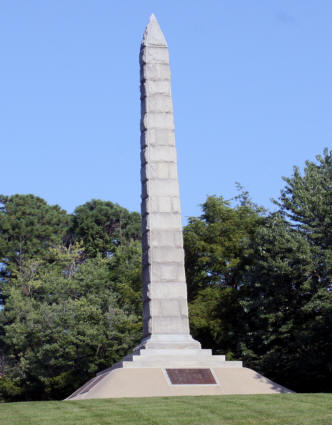 |
| Confederate Memorial |
Immediately after
Lincoln's election the southern states began succeeding from
the Union and formed a new country, The Confederate States
of America. (This is why Southerners object to the use of
the technically incorrect term "Civil War" since a civil war
is a war between two factions of
one country. By
1861, southern states had formed a new country, thus it was
not a civil war but a war between two separate countries.
Since the term "Civil War"
is shorter than its other nomenclatures,
it is very commonly used. )
During that war, over 600,000 Americans in both of
the countries were killed by other Americans. Two
cemeteries in Alton are filled with these soldiers. The
National Cemetery at 200 Pearl Street contains
a lot of them
and an unknown
number at the Confederate Cemetery at 635 Rozier
Street . In 1909, the United Daughters of the
Confederacy erected a 58' high granite obelisk to
commemorate the Confederate soldiers buried here or on
Smallpox Island. The
monument contains names of 1,354 Confederate soldiers who
died either in the
Alton Prison or on Tow Head Island, later named Smallpox
Island.
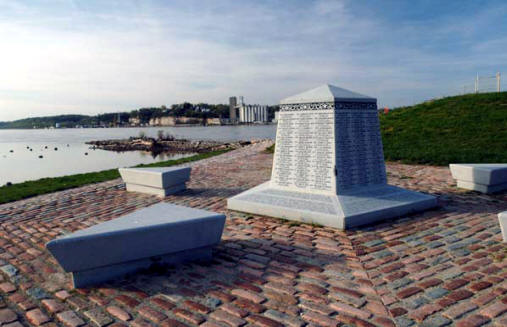 |
Monument to Confederate dead on Smallpox Island
Photo Credit: Gene
Kunz/Alton Regional CVB |
The Island got its name after the old Alton Prison which had
been closed down in 1860 mainly due to the complaints of its
unsanitary conditions lodged by social reformer Dorthea Dix.
In 1862, Lincoln ordered it reopened as a place to hold the
mounting number of Confederate prisoners. The maximum
capacity of Alton prison was estimated at 800; in the last
year of the war it held close to 1,900 Confederate
prisoners.
Through the three years it was in use,
over 11,764 Confederates passed through its gates.
Although it was not the harshest of the prisons, it was rife
with disease. Smallpox was common. In an effort to curb the
death rate, officials quarantined smallpox victims on Tow
Head Island in the Mississippi River. Those who died of the
disease were buried on the island rather than with the other
prisoners at the Confederate Cemetery. Due to flooding and
ravages of the river over the years, the graves and markers
have vanished.
A monument is all that remains there today.
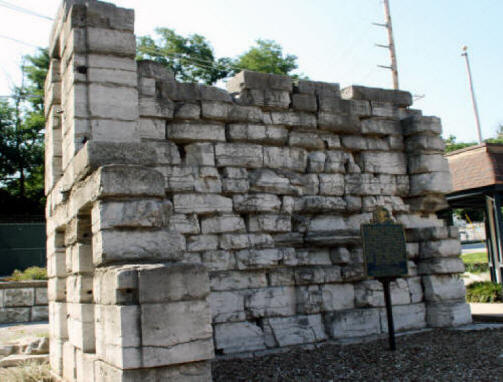 |
| Remnant of Alton's Prison |
The memories of this war will linger forever. Alton is
filled with historic mementoes of it and the Union Army's
Commander in Chief, Abraham Lincoln. Some consider him an
American hero and some don't.
No matter how you view
Abraham Lincoln, you must admit he was a man who raised
himself from his humble beginnings to the highest office in
the land. If you follow his trail from
Hodgenville. Kentucky through Springfield, Illinois to
Washington, D.C. be sure to visit
Alton and learn a lot of the lesser known story of this man
who made such a mark on American History.
For More Info:
Lincoln Birthplace National Historic Park
http://www.nps.gov/abli/index.htm
Lincoln Boyhood National Memorial Site
http://www.nps.gov/libo/index.htm
Indiana Lincoln State Park
http://www.in.gov/dnr/parklake/2979.htm
Alton's Lincoln and Civil War Legacy Trail
http://www.visitalton.com/lincoln





















